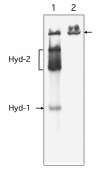The respiratory molybdo-selenoprotein formate dehydrogenases of Escherichia coli have hydrogen: benzyl viologen oxidoreductase activity
- PMID: 21806784
- PMCID: PMC3160892
- DOI: 10.1186/1471-2180-11-173
The respiratory molybdo-selenoprotein formate dehydrogenases of Escherichia coli have hydrogen: benzyl viologen oxidoreductase activity
Abstract
Background: Escherichia coli synthesizes three membrane-bound molybdenum- and selenocysteine-containing formate dehydrogenases, as well as up to four membrane-bound [NiFe]-hydrogenases. Two of the formate dehydrogenases (Fdh-N and Fdh-O) and two of the hydrogenases (Hyd-1 and Hyd-2) have their respective catalytic subunits located in the periplasm and these enzymes have been shown previously to oxidize formate and hydrogen, respectively, and thus function in energy metabolism. Mutants unable to synthesize the [NiFe]-hydrogenases retain a H₂: benzyl viologen oxidoreductase activity. The aim of this study was to identify the enzyme or enzymes responsible for this activity.
Results: Here we report the identification of a new H₂: benzyl viologen oxidoreductase enzyme activity in E. coli that is independent of the [NiFe]-hydrogenases. This enzyme activity was originally identified after non-denaturing polyacrylamide gel electrophoresis and visualization of hydrogen-oxidizing activity by specific staining. Analysis of a crude extract derived from a variety of E. coli mutants unable to synthesize any [NiFe]-hydrogenase-associated enzyme activity revealed that the mutants retained this specific hydrogen-oxidizing activity. Enrichment of this enzyme activity from solubilised membrane fractions of the hydrogenase-negative mutant FTD147 by ion-exchange, hydrophobic interaction and size-exclusion chromatographies followed by mass spectrometric analysis identified the enzymes Fdh-N and Fdh-O. Analysis of defined mutants devoid of selenocysteine biosynthetic capacity or carrying deletions in the genes encoding the catalytic subunits of Fdh-N and Fdh-O demonstrated that both enzymes catalyze hydrogen activation. Fdh-N and Fdh-O can also transfer the electrons derived from oxidation of hydrogen to other redox dyes.
Conclusions: The related respiratory molybdo-selenoproteins Fdh-N and Fdh-O of Escherichia coli have hydrogen-oxidizing activity. These findings demonstrate that the energy-conserving selenium- and molybdenum-dependent formate dehydrogenases Fdh-N and Fdh-O exhibit a degree of promiscuity with respect to the electron donor they use and identify a new class of dihydrogen-oxidizing enzyme.
Figures




Similar articles
-
Efficient electron transfer from hydrogen to benzyl viologen by the [NiFe]-hydrogenases of Escherichia coli is dependent on the coexpression of the iron-sulfur cluster-containing small subunit.Arch Microbiol. 2011 Dec;193(12):893-903. doi: 10.1007/s00203-011-0726-5. Epub 2011 Jun 30. Arch Microbiol. 2011. PMID: 21717143
-
Chromogenic assessment of the three molybdo-selenoprotein formate dehydrogenases in Escherichia coli.Biochem Biophys Rep. 2015 Mar 30;1:62-67. doi: 10.1016/j.bbrep.2015.03.006. eCollection 2015 May. Biochem Biophys Rep. 2015. PMID: 29124134 Free PMC article.
-
Zymographic differentiation of [NiFe]-hydrogenases 1, 2 and 3 of Escherichia coli K-12.BMC Microbiol. 2012 Jul 6;12:134. doi: 10.1186/1471-2180-12-134. BMC Microbiol. 2012. PMID: 22769583 Free PMC article.
-
The Model [NiFe]-Hydrogenases of Escherichia coli.Adv Microb Physiol. 2016;68:433-507. doi: 10.1016/bs.ampbs.2016.02.008. Epub 2016 Mar 23. Adv Microb Physiol. 2016. PMID: 27134027 Review.
-
Multiple and reversible hydrogenases for hydrogen production by Escherichia coli: dependence on fermentation substrate, pH and the F(0)F(1)-ATPase.Crit Rev Biochem Mol Biol. 2012 May-Jun;47(3):236-49. doi: 10.3109/10409238.2012.655375. Epub 2012 Feb 7. Crit Rev Biochem Mol Biol. 2012. PMID: 22313414 Review.
Cited by
-
Reduction of selenite to Se(0) nanoparticles by filamentous bacterium Streptomyces sp. ES2-5 isolated from a selenium mining soil.Microb Cell Fact. 2016 Sep 15;15(1):157. doi: 10.1186/s12934-016-0554-z. Microb Cell Fact. 2016. PMID: 27630128 Free PMC article.
-
Homoacetogenesis in Deep-Sea Chloroflexi, as Inferred by Single-Cell Genomics, Provides a Link to Reductive Dehalogenation in Terrestrial Dehalococcoidetes.mBio. 2017 Dec 19;8(6):e02022-17. doi: 10.1128/mBio.02022-17. mBio. 2017. PMID: 29259088 Free PMC article.
-
Ecology and biotechnology of selenium-respiring bacteria.Microbiol Mol Biol Rev. 2015 Mar;79(1):61-80. doi: 10.1128/MMBR.00037-14. Microbiol Mol Biol Rev. 2015. PMID: 25631289 Free PMC article. Review.
-
Unlocking Survival Mechanisms for Metal and Oxidative Stress in the Extremely Acidophilic, Halotolerant Acidihalobacter Genus.Genes (Basel). 2020 Nov 24;11(12):1392. doi: 10.3390/genes11121392. Genes (Basel). 2020. PMID: 33255299 Free PMC article.
-
Anaerobic Formate and Hydrogen Metabolism.EcoSal Plus. 2016 Oct;7(1):10.1128/ecosalplus.ESP-0011-2016. doi: 10.1128/ecosalplus.ESP-0011-2016. EcoSal Plus. 2016. PMID: 27735784 Free PMC article. Review.
References
-
- Sawers G, Blokesch M, Böck A. In: EcoSal- Escherichia coli and Salmonella: Cellular and Molecular Biology. Curtiss III R.(Editor in Chief), editor. ASM Press, Washington, D.C; Anaerobic formate and hydrogen metabolism.http://www.ecosal.org September 2004, posting date.
-
- Sawers RG. Formate and its role in hydrogen production in Escherichia coli. Biochem Soc Trans. 2005;33:42–46. - PubMed
-
- Berg BL, Li J, Heider J, Stewart V. Nitrate-inducible formate dehydrogenase in Escherichia coli K-12. I. Nucleotide sequence of the fdnGHI operon and evidence that opal (UGA) encodes selenocysteine. J Biol Chem. 1991;266:22380–22385. - PubMed
Publication types
MeSH terms
Substances
LinkOut - more resources
Full Text Sources

